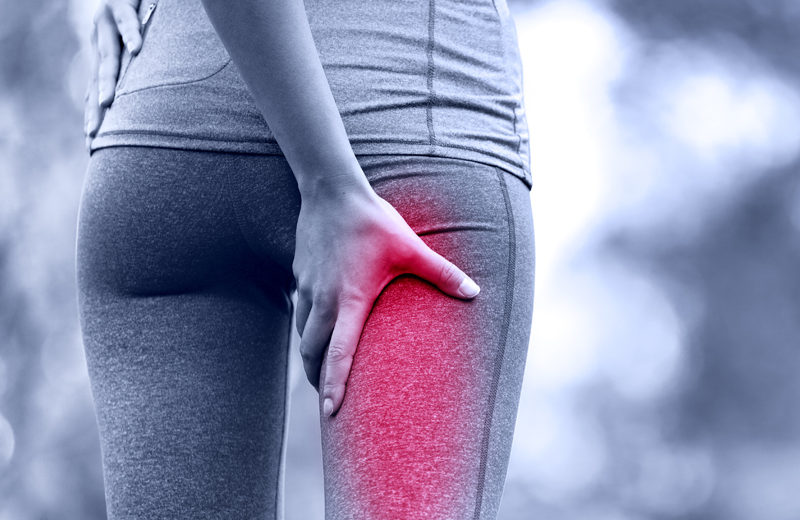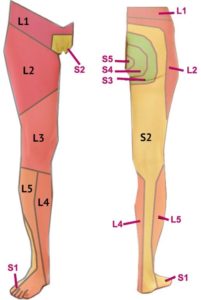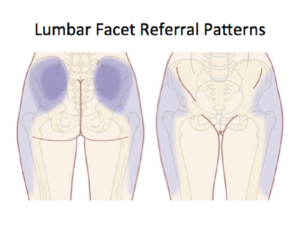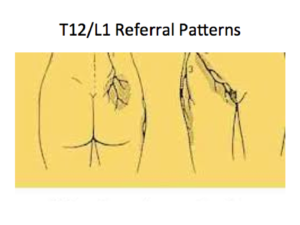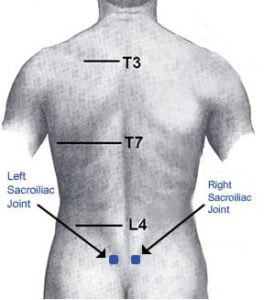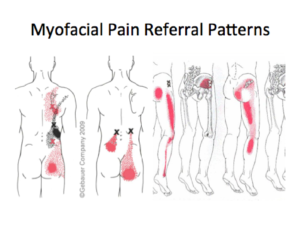The referral patterns of the Sacroiliac joint, facet joints, and myofascial system.
I often tell my patients that pain can be fools gold. Where you feel pain or sensation changes might not be the source. The musculoskeletal system a complex arrangement of muscles, joints, nerves, ligaments, tendons, and blood vessels all of which can be the source of pain and refer to other areas of the body.
Current research has attempted to provoke structures that may be causing referred symptoms in an effort to understand how referral patterns work in the body.
Dermatomes
A dermatome is an area of skin supplied by sensory neurons that arise from a spinal nerve. Symptoms that follow a dermatome (e.g. like pain, numbness, tingling, etc.) may indicate a pathology that involves the related nerve root as it arises from the spine. Dermatomes are useful to help localize neurologic levels, particularly in radiculopathy (pain, weakness, numbness, or difficulty controlling specific muscles). Encroachment of a spinal nerve may or may not exhibit symptoms in the dermatomal area covered by the compressed nerve roots in addition to weakness, or deep tendon reflex loss.
Lumbar facet joints
Facet joints are small joints at each segment of the spine that provide stability and motion. Facet joints can become painful due to arthritis, back injury, or mechanical stress. Mechanical dysfunction in the spine is very common and can result from everyday strain and injury often resulting in a “catch” or “crick.” Facet joint pain often refers pain distally (towards the limbs) from the source. The T-L junction or thoracolumbar area is a transitional vertebra where the thoracic and lumbar facets connect. Because the orientation of the thoracic and lumbar joints is different (lumbar facets allow backward bending and toe touch vs. thoracic allows side to side and rotation of the torso), this transitional area can be a common pain generator. Furthermore, a significant segment of the population presents with facet tropism at this level. Facet tropism is when on side of the facet is pointed the sagittal plane (flexion/extension) and the other side is in the coronal plane (side to side). Mechanical dysfunction at this level can mimic Sacroiliac joint pain (Maignes syndrome).
Sacroiliac Joint dysfunction
The sacroiliac joint can cause local and referred pain. The most common sign of sacroiliac joint dysfunction is the fortin finger test which is when the patient points to the PSIS (posterior superior iliac spine) as the source of pain. This point is the posterior (back) aspect of the SI joint.
In analysis of the pain diagrams of 50 patients who responded to fluoroscopy guided SI injection, Slipman CW et al found the following common referral patterns of the SI joint.
94% Buttock pain
72% Lower lumbar pain
14% Groin pain
50% LE pain
28% LE pain below knee
Slipman CW. et al. Sacroiliac joint pain referral zones. Arch Phys Med Rehab. 2000;8 1:334-8.
Myofascial pain
Muscles can cause both local and distal pain referred pain. Often times referred myofascial pain can be misdiagnosed as facet or discogenic pain. In the lower extremities the piriformis and gluteal muscles can often mimic sciatica. Myofascial pain can be significantly reduced with myofascial release and/or dry needling.

